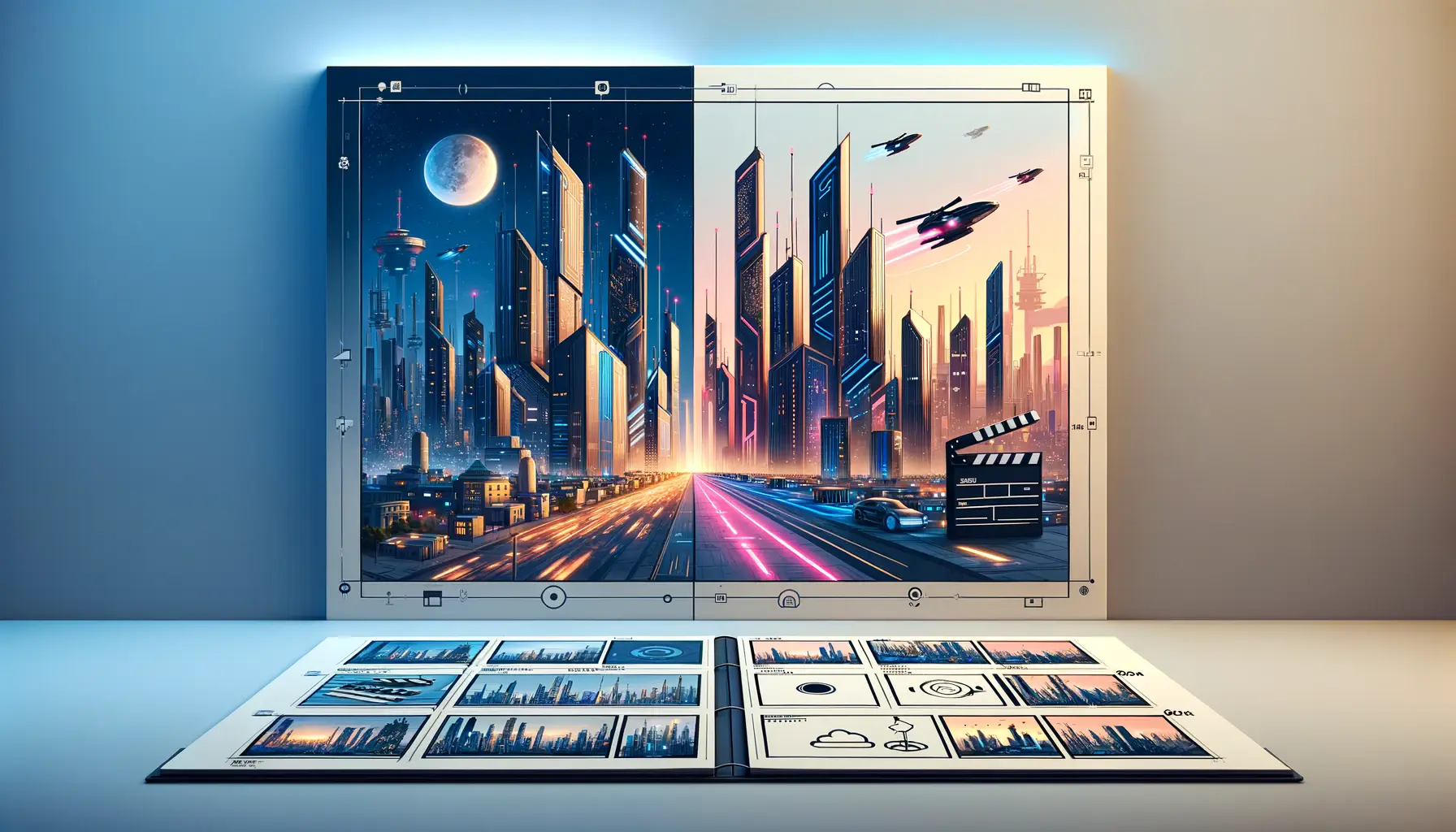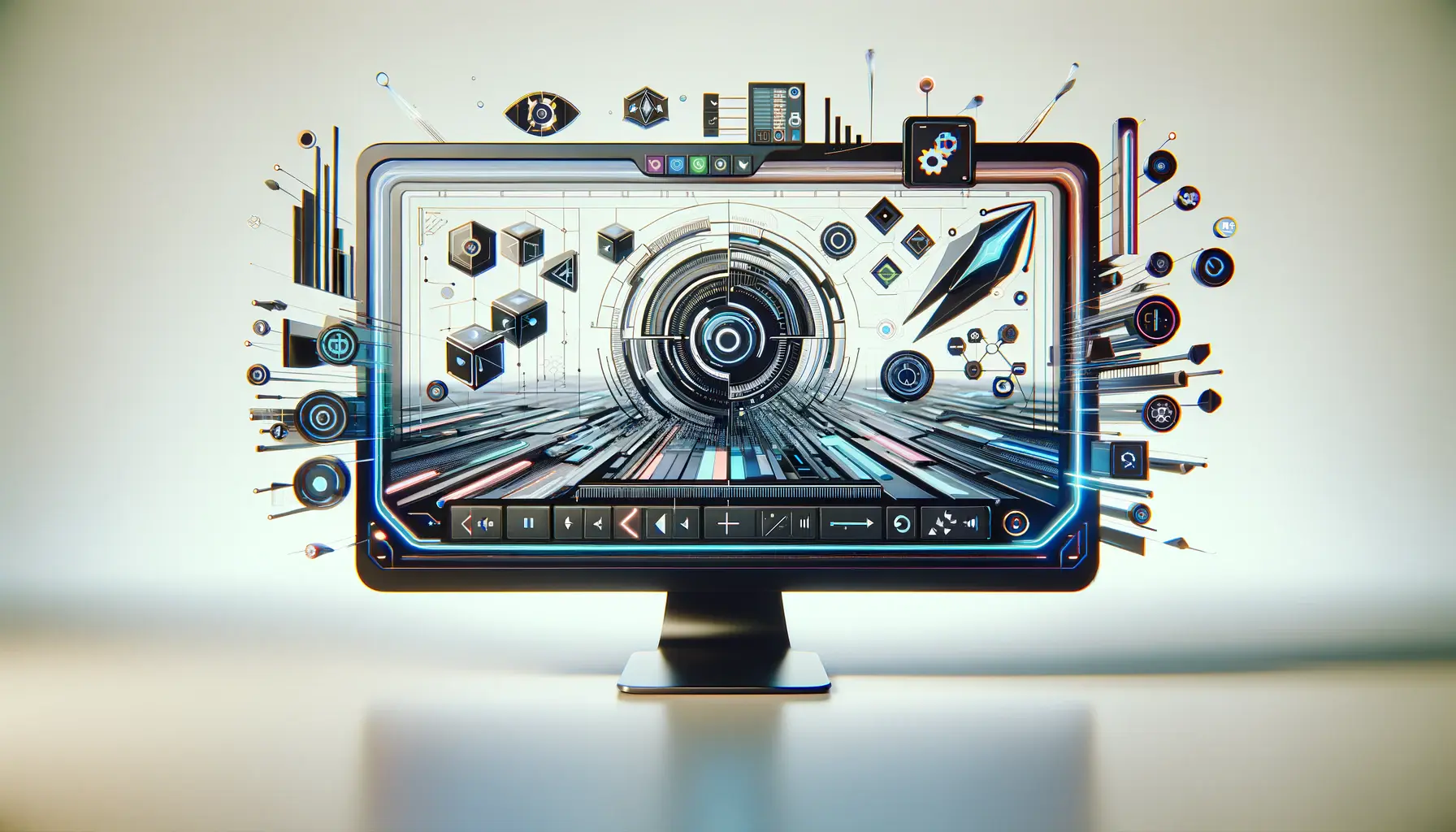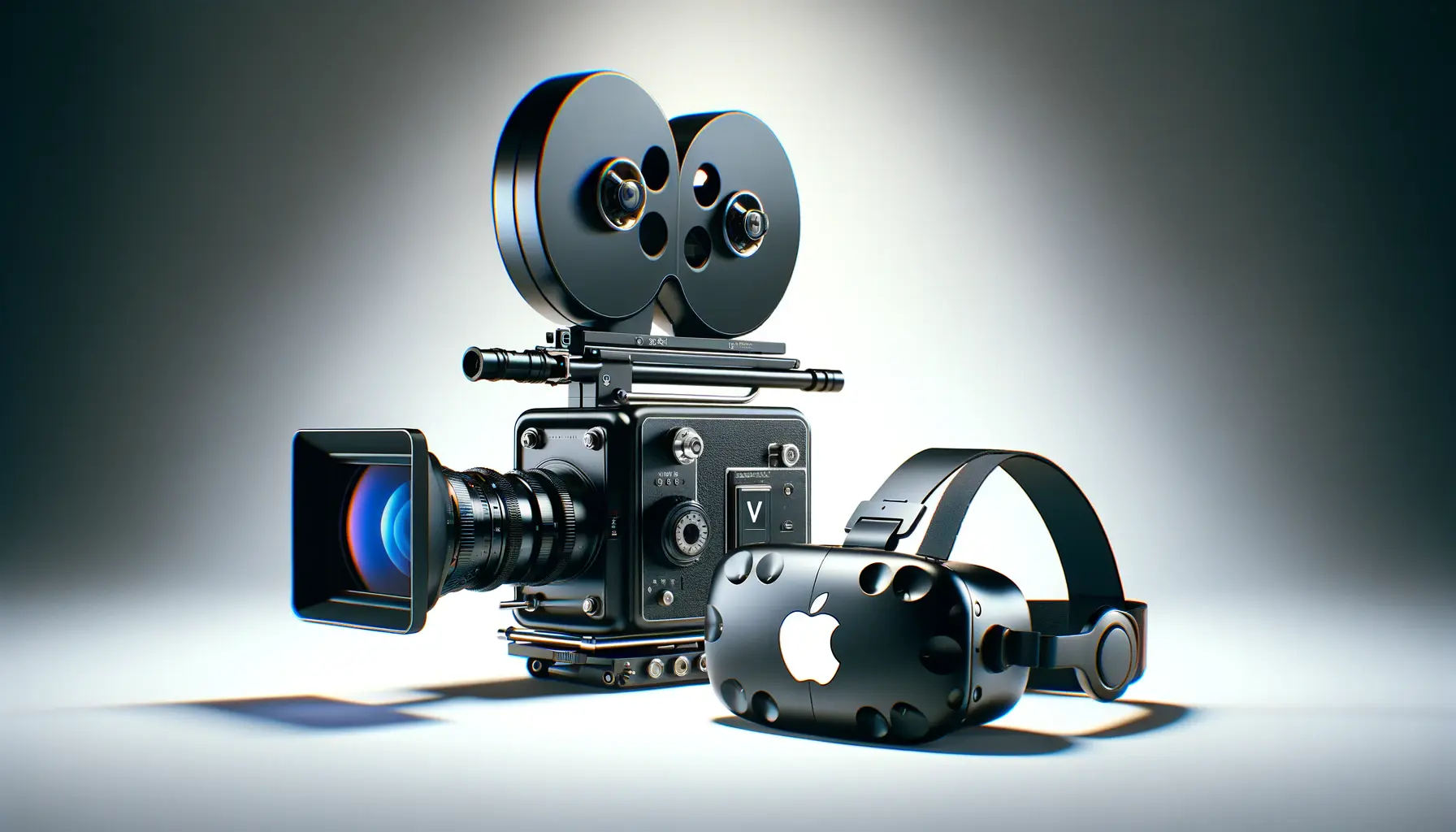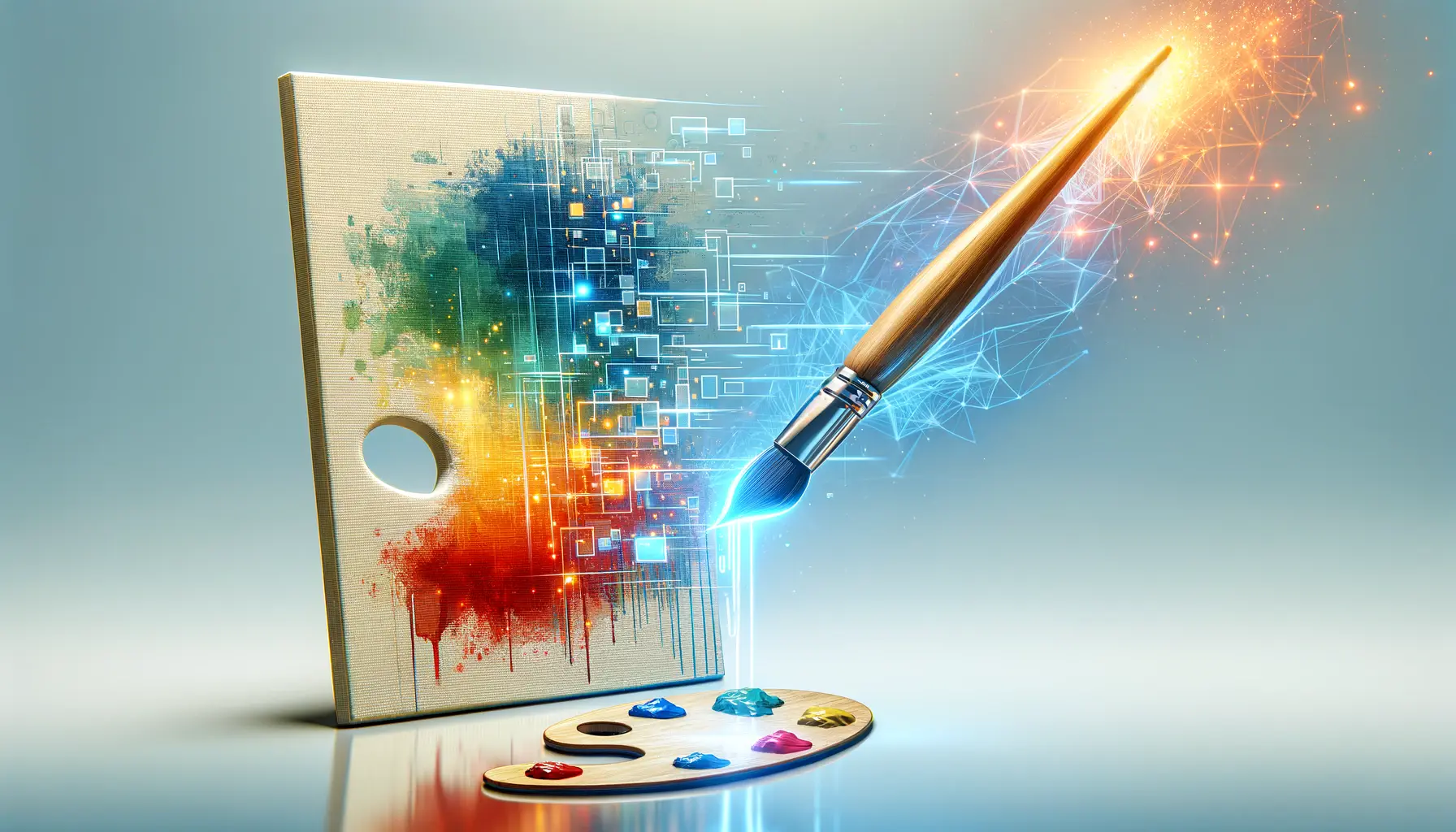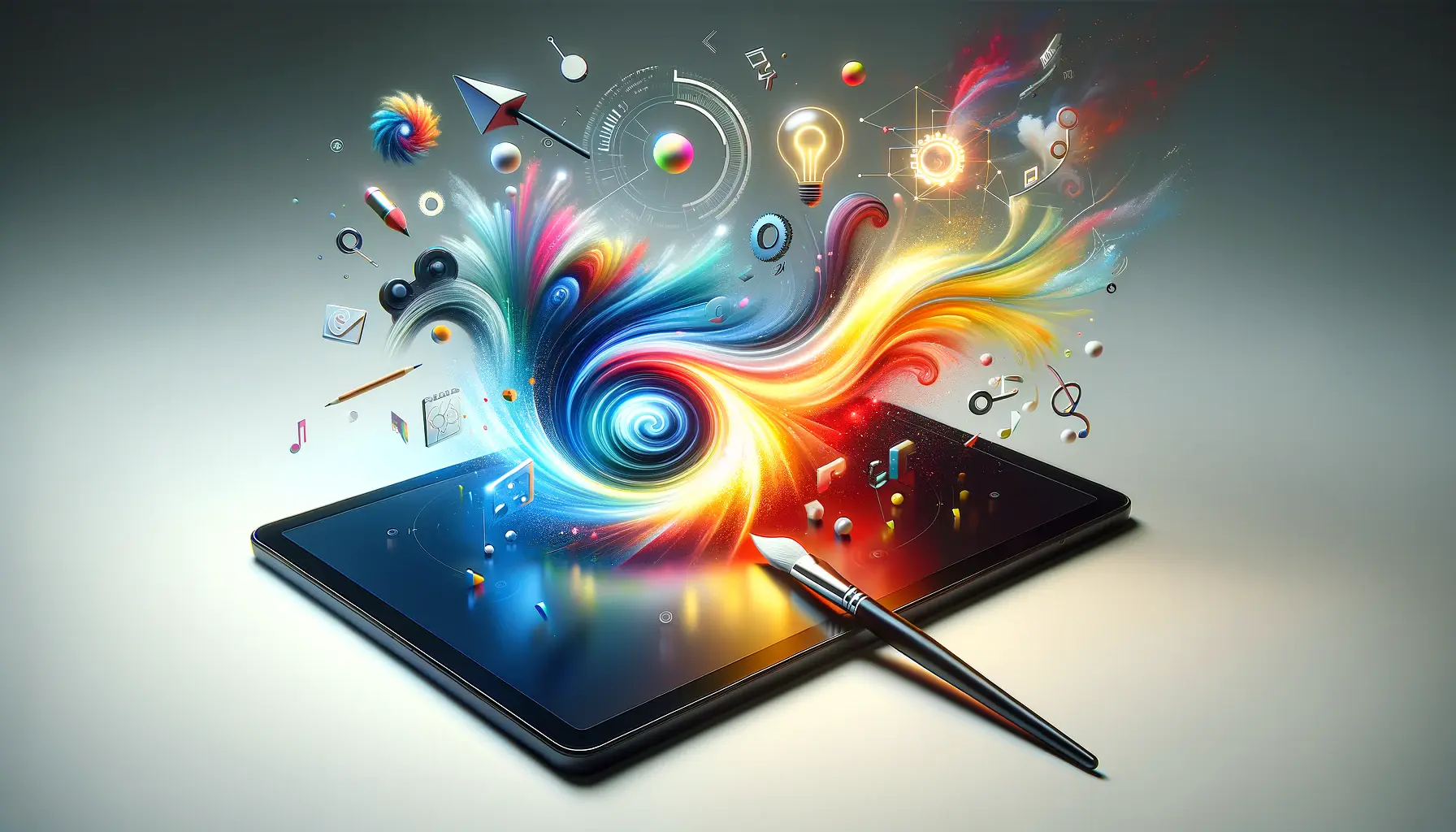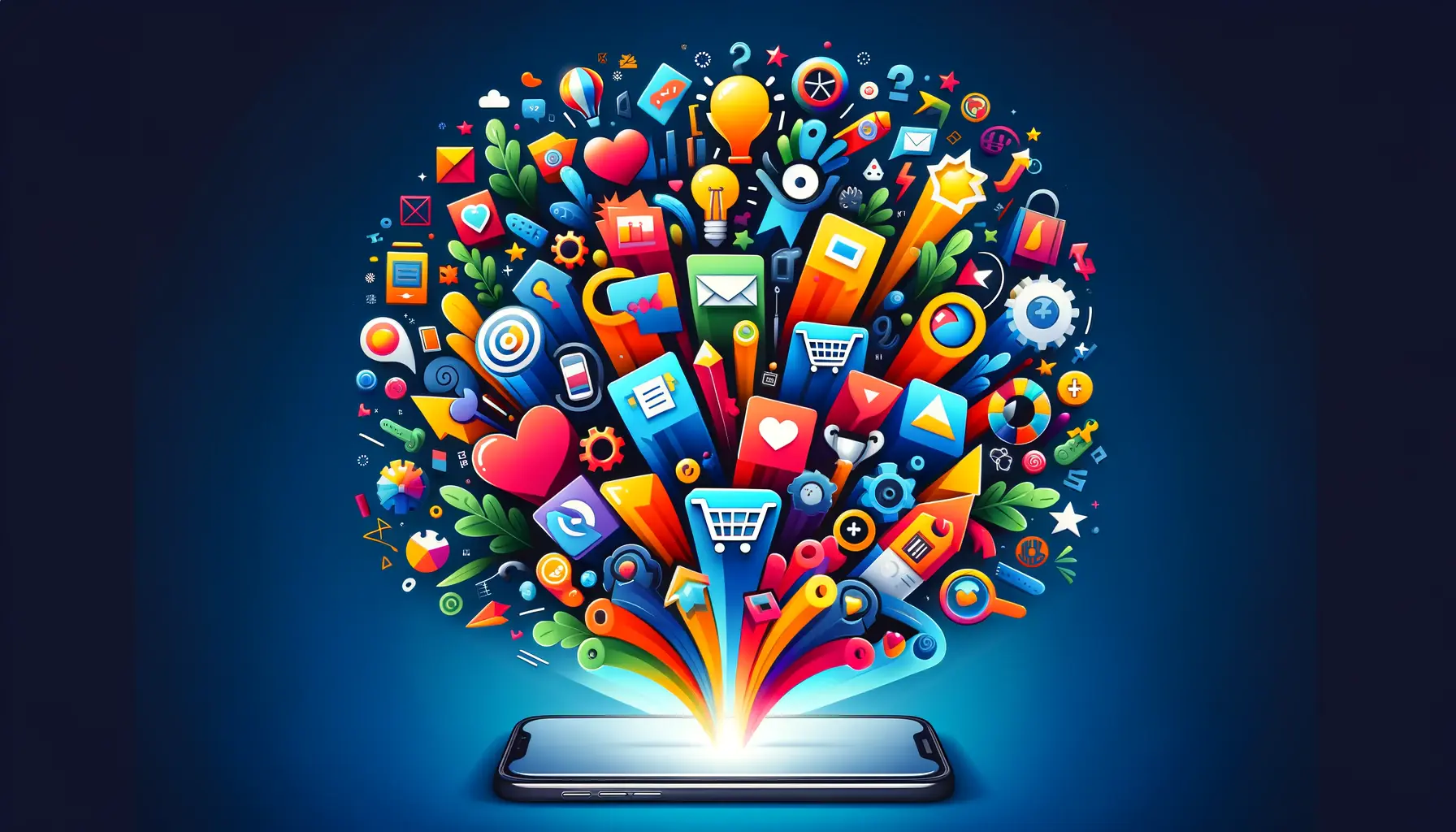The intersection of artificial intelligence and filmmaking has opened new horizons for creators around the globe.
Among the most revolutionary tools in this domain is DALL-E, an AI developed by OpenAI, which has become a cornerstone for filmmakers seeking to enhance their creative processes.
This article delves into how DALL-E is transforming the realms of concept art and storyboarding, offering filmmakers unprecedented capabilities to visualize their narratives.
With the main keyword being filmmakers, it’s essential to understand the impact of DALL-E within this community.
The tool’s ability to generate detailed images and art from textual descriptions allows filmmakers to explore visual ideas and concepts at an early stage, significantly streamlining the pre-production phase.
This capability not only saves time but also fosters a more creative exploration of visual storytelling elements.
- The Evolution of Storyboarding and Concept Art
- Integrating DALL-E into the Filmmaking Workflow
- Challenges and Solutions in Adopting AI for Filmmaking
- Future Trends in AI and Filmmaking
- Maximizing Creativity with DALL-E
- Collaborative Opportunities with DALL-E
- Practical Tips for Implementing DALL-E in Film Projects
- Embracing the Future of Filmmaking with DALL-E
- Frequently Asked Questions: DALL-E for Filmmakers
The Evolution of Storyboarding and Concept Art
The traditional methods of storyboarding and creating concept art have always been labor-intensive, requiring significant time and effort from artists and filmmakers.
However, the advent of DALL-E has introduced a paradigm shift, enabling the generation of complex visual ideas from simple text prompts.
This evolution marks a significant milestone in filmmaking, where the barrier between imagination and visual representation becomes increasingly blurred.
By leveraging DALL-E, filmmakers can now quickly iterate on visual concepts, experiment with different aesthetics, and make decisions more efficiently.
This shift not only accelerates the development process but also opens up new possibilities for storytelling, allowing for a more dynamic and flexible approach to visualizing scripts.
Case Studies in Filmmaking
Several filmmakers have already begun to explore the potential of DALL-E in their projects.
For instance, in the development of a sci-fi short film, a director used DALL-E to generate concept art for various alien landscapes and characters based on descriptive text inputs.
This process allowed the team to visualize and refine their ideas before committing to the expensive and time-consuming process of physical or digital production.
Another example involves an independent filmmaker who utilized DALL-E for creating storyboards for a complex action sequence.
By inputting detailed descriptions of each scene, the filmmaker was able to receive visual storyboards that closely matched their vision, significantly improving the planning and execution of the sequence.
DALL-E’s impact on filmmaking extends beyond mere convenience; it represents a fundamental shift in how filmmakers can visualize and execute their visions, making the creative process more accessible and efficient.
Integrating DALL-E into the Filmmaking Workflow
The integration of DALL-E into the filmmaking workflow signifies a transformative approach to visual storytelling.
This technology not only enhances the efficiency of the pre-production phase but also empowers filmmakers to push the boundaries of their creative visions.
Understanding the practical application of DALL-E in various stages of filmmaking is crucial for leveraging its full potential.
From initial concept development to the final stages of pre-visualization, DALL-E serves as a versatile tool that can adapt to the unique needs of each project.
Here’s how filmmakers can integrate this technology into their workflow:
- Concept Development: At the outset of a project, DALL-E can be used to generate a wide range of visual ideas based on the initial script or story outline. This helps in quickly establishing a visual language for the project.
- Character Design: For projects requiring unique character designs, DALL-E can produce varied interpretations of characters based on descriptive inputs, aiding in the selection of the most suitable designs for the story.
- Location Scouting: Filmmakers can use DALL-E to visualize potential locations or create entirely new environments that match the script’s requirements, reducing the need for extensive physical scouting.
- Storyboard Creation: DALL-E significantly streamlines the storyboard creation process by generating detailed scenes from textual descriptions. This allows for rapid iteration and refinement of the storyboard.
Enhancing Creative Collaboration
The use of DALL-E in filmmaking also fosters a more collaborative environment among the creative team.
By providing a common visual reference, team members can better communicate their ideas and contribute to the development of the project.
This collaborative process ensures that all aspects of the film’s visual style are cohesive and aligned with the director’s vision.
Furthermore, DALL-E enables filmmakers to experiment with different visual styles and themes at a fraction of the time and cost traditionally associated with these explorations.
This not only enhances the creative process but also allows for a more adaptive approach to filmmaking, where changes can be made swiftly without significant setbacks.
The integration of DALL-E into the filmmaking workflow represents a significant advancement in how films are conceived, developed, and visualized, marking a new era of creative freedom and efficiency in the industry.
Challenges and Solutions in Adopting AI for Filmmaking
While the adoption of DALL-E and similar AI technologies offers numerous advantages for filmmakers, it also presents certain challenges.
These challenges range from technical limitations to ethical considerations, each requiring thoughtful solutions to ensure that the integration of AI into filmmaking is both productive and responsible.
Understanding these challenges is crucial for filmmakers who wish to harness the power of AI without compromising the integrity of their creative vision or the practical aspects of their production process.
Technical Limitations and Overcoming Them
One of the primary challenges in using DALL-E for filmmaking is the tool’s current technical limitations.
These include issues such as the resolution of generated images, the accuracy of complex visual translations, and the AI’s understanding of nuanced human emotions.
To overcome these limitations, filmmakers can employ a combination of AI-generated content and traditional artistic input, ensuring that the final visuals meet the high standards required for professional film production.
Additionally, continuous advancements in AI technology suggest that many of these limitations will be addressed in future updates.
Staying informed about these developments and actively participating in the AI community can help filmmakers make the most of these evolving tools.
Ethical Considerations in AI-generated Content
Another significant challenge is the ethical consideration of using AI to generate creative content.
Issues such as copyright infringement, the originality of AI-generated art, and the potential for AI to replace human jobs in the creative industry are of concern.
Filmmakers must navigate these ethical waters carefully, ensuring that their use of AI respects copyright laws, contributes to the originality of their work, and complements rather than replaces the human element in creativity.
To address these concerns, it’s essential for filmmakers to use AI as a tool for enhancement rather than replacement.
By doing so, they can leverage AI’s capabilities to augment their creative process, ensuring that the technology serves as a collaborator in the artistic journey rather than a substitute for human creativity.
While the integration of AI like DALL-E into filmmaking presents challenges, these can be mitigated through a balanced approach that combines AI’s strengths with human creativity and ethical considerations.
Future Trends in AI and Filmmaking
The integration of AI technologies like DALL-E into the filmmaking process is not just a passing trend but a glimpse into the future of the industry.
As these technologies continue to evolve, they are set to redefine the boundaries of what is possible in film production and storytelling.
Anticipating future trends in AI and filmmaking is essential for professionals looking to stay ahead in the rapidly changing landscape of the industry.
Understanding these trends will enable filmmakers to harness the full potential of AI, ensuring that they can leverage these technologies to enhance their creative visions and production efficiencies.
Advancements in AI Technology
- Improved Realism: Future iterations of DALL-E and similar AI tools are expected to produce even more realistic and high-resolution images, making them indistinguishable from photographs or traditional art. This will further blur the line between AI-generated and human-created content.
- Enhanced Understanding of Context: AI’s ability to understand and interpret complex narrative contexts will improve, allowing for more accurate and nuanced visual representations based on textual descriptions.
- Interactive Storytelling: AI could enable new forms of interactive storytelling, where the visual elements of a film adapt in real-time based on audience reactions or choices, creating a personalized viewing experience.
Impact on the Film Industry
- Democratization of Filmmaking: As AI tools become more accessible and user-friendly, more individuals will have the opportunity to create and visualize their stories, democratizing the filmmaking process.
- Collaboration Between AI and Human Creativity: The future will likely see a more integrated approach to filmmaking, where AI and human creativity collaborate seamlessly, each enhancing the other’s strengths.
- New Genres and Narratives: The capabilities of AI will inspire filmmakers to explore new genres and narratives that were previously difficult or impossible to visualize, expanding the horizons of cinematic storytelling.
The future of filmmaking with AI promises a landscape where creative possibilities are limitless, and the traditional barriers to film production are significantly reduced.
Maximizing Creativity with DALL-E
The advent of DALL-E in the realm of filmmaking has not only streamlined various aspects of the production process but also significantly enhanced the creative capabilities of filmmakers.
By providing a tool that can translate textual descriptions into detailed images, DALL-E empowers filmmakers to explore their creativity without the constraints of traditional production limitations.
Maximizing the creative potential of DALL-E involves understanding its capabilities and applying them in innovative ways to enhance storytelling.
Here are strategies for filmmakers to harness the full creative power of DALL-E, ensuring that their visions are not just realized but elevated.
Exploring Uncharted Visual Territories
- Experimentation: Filmmakers should embrace experimentation with DALL-E, using it to generate a wide range of visual outputs from a single text prompt. This can lead to unexpected and inspiring visual concepts that could define the look and feel of a film.
- Combining Inputs: By combining various descriptive inputs and prompts, filmmakers can discover unique visual styles or elements that enhance their narrative, pushing the boundaries of traditional visual storytelling.
Refining the Art of Visual Storytelling
- Iterative Design Process: DALL-E facilitates an iterative design process, allowing filmmakers to refine their visual concepts rapidly. This iterative process ensures that the final visuals are perfectly aligned with the filmmaker’s vision.
- Detailing and Depth: Filmmakers can use DALL-E to add layers of detail and depth to their visual storytelling, enriching the narrative and creating a more immersive experience for the audience.
Enhancing Narrative with Visual Innovations
- Visual Metaphors: DALL-E can be used to create powerful visual metaphors that enhance the narrative, providing a visual representation of themes or concepts that are difficult to convey through words alone.
- Symbolism and Imagery: The tool also allows for the exploration of symbolism and imagery, enabling filmmakers to weave complex narratives that resonate deeply with audiences.
The true potential of DALL-E in filmmaking lies in its ability to unlock new dimensions of creativity, allowing filmmakers to explore, refine, and enhance their narratives in ways previously unimaginable.
Collaborative Opportunities with DALL-E
The integration of DALL-E into the filmmaking process opens up a plethora of collaborative opportunities, not just within the confines of individual projects but across the broader industry.
By facilitating a more dynamic exchange of ideas and visual concepts, DALL-E acts as a catalyst for creative collaboration, bringing together diverse talents and perspectives to enrich the filmmaking process.
This collaborative potential can be harnessed in various ways to enhance both the efficiency and creativity of film projects.
Interdisciplinary Collaboration
One of the most significant impacts of DALL-E is its ability to bridge the gap between different creative disciplines.
Artists, writers, designers, and technologists can collaborate more effectively, using DALL-E as a common platform to visualize and refine ideas.
This interdisciplinary approach not only enriches the creative process but also ensures that all aspects of a film’s production are aligned with the director’s vision.
Global Creative Networks
DALL-E also facilitates the formation of global creative networks, allowing filmmakers to collaborate with artists and creators from around the world.
By sharing DALL-E-generated visuals, teams can work together remotely, overcoming geographical barriers and tapping into a diverse pool of talent.
This global collaboration enriches film projects with a wide range of cultural perspectives and artistic styles, enhancing the storytelling and visual impact of films.
Community Engagement and Feedback
Furthermore, DALL-E enables filmmakers to engage with their audiences in the creative process.
By sharing concept art and storyboards generated with DALL-E on social media or crowdfunding platforms, filmmakers can gather feedback and gauge audience interest early in the development process.
This direct engagement not only builds anticipation for the project but also provides valuable insights that can inform creative decisions.
The collaborative opportunities afforded by DALL-E extend beyond traditional filmmaking boundaries, fostering a more inclusive, dynamic, and globally connected creative community.
Practical Tips for Implementing DALL-E in Film Projects
Implementing DALL-E into film projects requires a strategic approach to fully leverage its capabilities while navigating the challenges it presents.
For filmmakers eager to integrate this AI technology into their workflow, practical tips and best practices can make the transition smoother and more effective.
These guidelines are designed to help filmmakers harness the power of DALL-E, ensuring that it enhances their creative process and contributes positively to their projects.
Starting with Clear Objectives
- Define Your Needs: Begin by clearly defining what you hope to achieve with DALL-E. Whether it’s generating concept art, creating storyboards, or exploring new visual styles, having clear objectives will guide your use of the tool.
- Understand the Tool’s Capabilities: Familiarize yourself with DALL-E’s features and limitations. Knowing what the AI can and cannot do will help you set realistic expectations and use it more effectively.
Optimizing Text Prompts for Better Results
- Be Specific: The specificity of your text prompts directly influences the quality of DALL-E’s outputs. Detailed descriptions yield more accurate and useful visualizations.
- Experiment with Variations: Don’t hesitate to experiment with different phrasings and details in your prompts. This can help you explore a wider range of visual possibilities and find the best fit for your project.
Integrating DALL-E into the Creative Workflow
- Collaborative Feedback: Use DALL-E-generated visuals as a basis for discussion and feedback within your team. This collaborative review process can spark new ideas and refine existing ones.
- Iterative Refinement: Treat DALL-E’s outputs as starting points, not final products. Use them to iterate and refine your visual concepts, combining AI-generated elements with traditional artistic inputs as needed.
Staying Informed and Adaptable
- Keep Up with AI Developments: The field of AI is rapidly evolving. Stay informed about the latest advancements in AI technology and how they can benefit your filmmaking process.
- Be Open to New Possibilities: DALL-E can open up new creative avenues that you hadn’t considered. Be open to these possibilities and willing to adapt your creative approach accordingly.
By following these practical tips, filmmakers can effectively integrate DALL-E into their projects, enhancing their creative capabilities and streamlining their production workflows.
Embracing the Future of Filmmaking with DALL-E
The integration of DALL-E into the filmmaking process represents a significant leap forward in the way filmmakers approach the creation of concept art and storyboards.
This AI tool has not only streamlined the pre-production phase but also opened up new avenues for creative expression, allowing filmmakers to explore visual ideas that were previously beyond reach.
As we have seen, DALL-E offers a range of benefits, from enhancing the efficiency of the filmmaking process to fostering collaborative opportunities and pushing the boundaries of narrative storytelling.
The Transformative Impact of DALL-E on Filmmakers
For filmmakers, the advent of DALL-E signifies a shift towards a more innovative and flexible approach to visual storytelling.
The ability to quickly generate detailed images from textual descriptions allows for rapid exploration of visual concepts, character designs, and storyboards.
This capability not only saves valuable time and resources but also encourages a more dynamic and experimental approach to filmmaking.
By leveraging DALL-E, filmmakers can now bring their most ambitious visions to life with unprecedented ease and precision.
Navigating Challenges and Maximizing Potential
Despite its many advantages, the adoption of DALL-E in filmmaking also presents challenges that require careful consideration.
Technical limitations, ethical concerns, and the need for a balanced integration of AI and human creativity are among the key issues that filmmakers must navigate.
However, by adopting best practices and staying informed about advancements in AI technology, filmmakers can overcome these challenges and fully harness the potential of DALL-E to enhance their creative processes.
Looking Ahead: The Future of AI in Filmmaking
The future of filmmaking with DALL-E and similar AI technologies is bright, with ongoing advancements promising to further enhance their capabilities and applications.
As AI tools become more sophisticated, we can expect to see even more realistic and complex visual outputs, deeper integration into various stages of the filmmaking process, and new forms of interactive and immersive storytelling.
For filmmakers, staying at the forefront of these developments will be key to leveraging AI as a powerful ally in the art of storytelling.
- The democratization of filmmaking, as DALL-E lowers the barriers to entry for aspiring filmmakers by providing them with powerful tools to visualize their ideas.
- The enhancement of collaborative creativity, enabling a more inclusive and diverse exploration of narrative and visual storytelling across cultures and disciplines.
- The continuous evolution of narrative forms, as AI-generated visuals inspire filmmakers to explore new genres, themes, and storytelling techniques.
In conclusion, DALL-E represents a pivotal development for filmmakers, offering both opportunities and challenges.
By embracing this technology, filmmakers can enhance their creative capabilities, streamline their workflows, and engage in more meaningful collaborations.
As we look to the future, the role of DALL-E and AI in filmmaking will undoubtedly continue to grow, shaping the industry in profound and exciting ways.
For filmmakers, the journey with DALL-E is just beginning, and the possibilities are as limitless as their imaginations.
Frequently Asked Questions: DALL-E for Filmmakers
Explore the most common inquiries about utilizing DALL-E in the filmmaking process, providing insights and practical advice for creative professionals.
DALL-E is an AI by OpenAI that generates images from textual descriptions, aiding filmmakers in concept art creation and storyboarding efficiently.
Yes, filmmakers own the rights to images created with DALL-E, including the ability to sell, reprint, and use them in merchandise.
No, DALL-E is designed to augment the creative process, not replace human filmmakers, by providing tools for enhanced visual storytelling.
DALL-E streamlines storyboard creation by generating detailed visual scenes from textual descriptions, saving time and fostering creativity.
Limitations include resolution of generated images, interpretation accuracy, and the AI’s understanding of complex narratives.
Filmmakers can begin by accessing DALL-E through OpenAI, experimenting with text prompts to generate visuals for their projects.
Considerations include respecting copyright laws, ensuring originality in AI-generated content, and balancing AI use with human creativity.
DALL-E is expected to democratize filmmaking by making advanced visual creation tools accessible, encouraging innovative storytelling.
